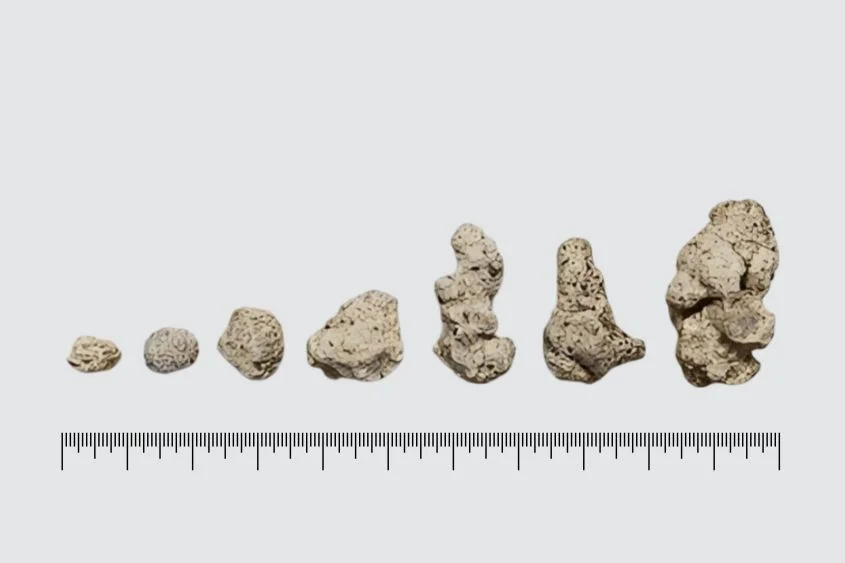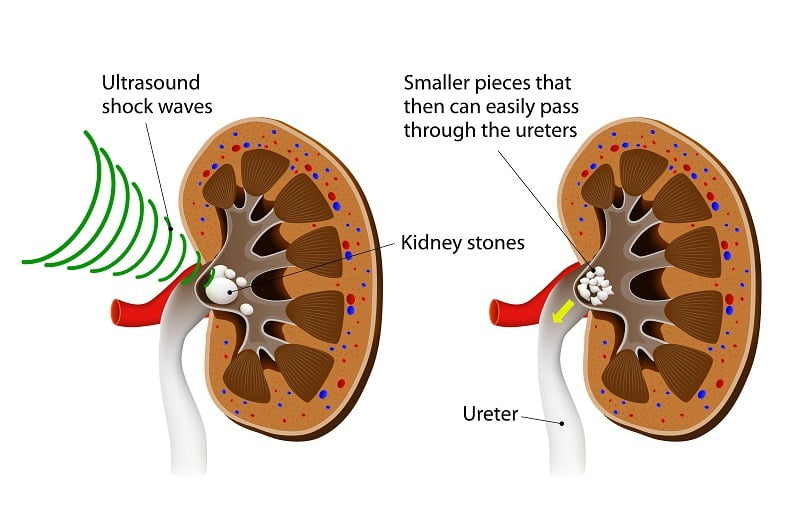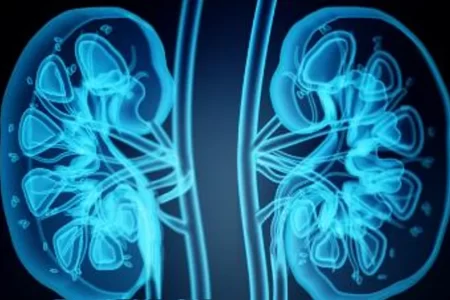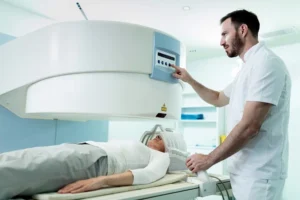How Big Are Kidney Stones? Size Chart
- Updated on: Jun 15, 2024
- 8 min Read
- Published on Feb 3, 2021

What Are Kidney Stones (Renal Calculi)?
Kidney stones are crystal like hard substances formed within the urinary system, which are often scientifically termed as Nephrolithasis. These stones are formed due to decrease in urine volume or accumulation of unwanted toxic substances. Dehydration is the major cause of occurrence of kidney stones. Also known as renal calculi, kidney stones have a highly distant physical appearance. Other primary causes are dietary habits, metabolic disorders, genetics, certain medications, and specific medical conditions.
Varying Sizes of Kidney Stones
Kidney stones can vary in size widely, ranging from tiny crystals, such as “gravel” or “sand-like,” to significantly larger stones that can grow to the size of a golf ball or even bigger in some cases. The size of a kidney stone determines the symptoms a person may experience, the potential complications that could arise with such stones, and the treatment options required to manage or remove these stones.
Small kidney stones, measuring less than 4-5 mm, might pass through the urinary tract naturally without causing significant discomfort, while larger stones, exceeding 6 mm, can become lodged and block the flow of urine. This may cause severe pain, infection, or even kidney damage. In rare cases, when you have exceptionally large stones, known as staghorn calculi, they can occupy a significant portion of the kidney. These very large stones require complex surgical interventions.
The size of kidney stones affect the treatment method required for their removal. Small-sized stones can easily pass through the kidney without any medical assistance but large-sized stones require medical intervention. Certain tests are conducted which help in determining the size of kidney stones, such as KUB, an Ultrasound or an IVP. They help in analyzing which treatment should be effective for the removal of your kidney stones.
“According to the National Kidney Foundation, it is estimated that one in ten people will have a kidney stone sometime in their lives. The prevalence of kidney stones has increased significantly in the United States from 3.8% in the late 1970s to 8.8% in the late 2000s. The lifetime risk of developing kidney stones is about 11% in men and 9% in women. Conditions such as high blood pressure, diabetes, and obesity may increase the risk for kidney stones.”
What is a Kidney Stone Size Chart (presented in mm and cm)?
Kidney stones vary in sizes. The composition, their treatment and removal, time they take in passing through the urine, and their other characteristics varies based on their sizes. A kidney stone size chart is an easy way to tabulate and illustrate important information about one or more of these factors associated with varying sizes of kidney stones.
A kidney stone size chart may show a correlation between possible treatment options and various sizes of the kidney stone. Another type of a kidney stone size chart may show correlation between kidney stone sizes and their compositions and so on. We will discuss these aspects in this article below.
Kidney Stone Size Chart and Its Features
This is a simple kidney stone size chart that provides important information about the chances of passing stones naturally, time taken, and treatment required for various sizes of the kidney stones. More types of kidney stone charts can be possible to show different types of information pieces about kidney stones and their sizes.
| Size of kidney stones | Chances of passing naturally | Time required to pass naturally |
|---|---|---|
| Less than 2mm | About 80% | 8 days (average) |
| 2-4 mm | About 80% | 12 days (average) |
| 4mm | About 80% | 31 days (average) |
| 4-7mm | About 60% | 45 days (average) |
| Larger than 7mm | About 20% | 12 months (average) |
| 1-2cm | Cannot pass | |
| Larger than 2cm | Cannot pass |
Relation Between Kidney Stone Size and Their Composition
The size of the stones can also indicate the compounds they are made of. Kidney stones can have a variety of compositions such as calcium, uric acid, struvite and cystine stones. They are formed by deposition of toxic compounds in the kidneys. An increased deposition of toxic compounds may result in the formation of large-sized kidney stones, which can cause blockage in the urine path.
This chart below indicates various types of kidney stones and their shapes and sizes.
| Type of stones | Incidence rate | Shape | Cause | Clinical risk factors |
|---|---|---|---|---|
| Calcium oxalate | About 80% | Envelop | Increased calcium and oxalate in urine | Higher chances in middle age men than women |
| Calcium phosphate | < 5% | Amorphous | Increased calcium and pH | Hyperparathyroidism and renal tubular acidosis |
| Uric acid | About 10% | Diamond or rhomboid | Increased uric acid and pH of urine | Gout and diabetes mellitus |
| Struvite | About 10% | Coffin-lid | Increased pH of urine | Neurogenic bladder and other anatomic abnormality |
| Cystine | < 1% | Hexagonal | Rare genetic disorder: increased cystine in urine |

Treatment and Removal of Small Kidney Stones Naturally (up to 4 mm)
Kidney stones of less than 5mm are categorized as small. Small kidney stones can easily pass through the urinary tract without any medical assistance. 4mm sized stones have 80% chances to pass through the kidneys in about a month, but 5mm size stones have 60% chances of passage in about 45 days.
To pass small-sized kidney stones naturally in urine, certain home remedies can be helpful such as increased fluid intake, increased water, lemon and citrus juice consumption and low salt, calcium and protein diet. High water concentration does not allow growth of kidney stones and they can slowly pass along with the urine.
If you experience any pain in the lower abdomen during passing of the kidney stones, you can take an analgesic such as ibuprofen or any other painkiller as suggested by the doctor. Painkillers help in relieving pain and also speed up the process of passing the stone. Read about relieving kidney pain.

Treatment for Medium-Sized Kidney stones (4 to 10 mm)
Medium-sized stones that are typically 4 mm to 10 mm in size can be treated through home remedies and conservative methods such as medication (alpha-blockers and painkillers). There may be situations when these stones may not respond to conservative treatment. Your doctor may then suggest a medical procedure or minimally-invasive surgery for their treatment. These treatments may include such as the following.
ESWL or Extracorporeal Shock Wave Lithotripsy: This is a non-invasive procedure for kidney stone removal. Your surgeon will use high-energy sound waves to break the stones into smaller pieces which can then be flushed out of the system on their own. This takes 30 to 45 minutes to be conducted, and the patient is allowed to go back home on the same day.
Extracorporeal shock wave lithotripsy is the most common method for the treatment of medium sized stones which cannot pass through the urine. This involves administration of ultrasound (high-frequency sound waves), which results in breakdown of the stones into smaller pieces so they can easily pass along with urine.

URSL or Ureteroscopic Lithotripsy: The procedure involves extracting the kidney stones with the help of a ureteroscope which is a long fiber-optic scope. The scope is inserted into the ureteral passage through the urethra. An x-ray is simultaneously performed to determine the location of the stone. The doctor then uses a stone basket to collect the stones and remove them from the body. If the stones are too big in size, your surgeon may use a laser to break them into small pieces first, and then flush them out of the system naturally. A stent is inserted to widen the passage of the ureter for about 15 days, allowing stones to pass easily. The stent is then removed under anaesthesia or without anaesthesia as well depending on preference of the surgeon.
Treatment of Large-Sized Kidney Stones (10 mm)
Have you ever wondered how big are kidney stones? Stones of 10 mm size or more are considered as large kidney stones. Large-sized stones cannot pass through the kidneys without any medical intervention. If they are left to pass on their own, they may take longer time, about a year or more than that and there is a risk of complications. Large sized stones may get struck in the urinary tract and cause extreme pain and bleeding during urination.
The methods involved in the removal of large-sized kidney stones, such as kidney stone surgery, are as follows:
Ureteroscopy
Ureteroscopy is also known as retrograde intrarenal surgery (RIS). When large-sized kidney stones get stuck in the ureter, ureteroscopy may be carried out.
This involves inserting a ureterscope (long, thin telescope) through urethra into the bladder, to the site where the stone got struck in the ureter. Your surgeon may remove the stone using another instrument or by laser energy, which breaks the stone into smaller pieces and allow it to pass naturally through the kidneys.
Percutaneous Nephrolithotomy (PCNL)
Percutaneous nephrolithotomy is suitable for removal of extremely large-sized stones and for obese people. This involves passing a nephroscope (thin telescopic instrument) into the kidneys through a small incision in the back. The stone is then either pulled out or broken into small pieces by pneumatic energy.
Open Surgery for Kidney Stones Removal
Open surgery is carried out in rare cases, either when you have a huge stone or abnormal anatomy. This involves an incision to be made in the back to provide access to your ureter or kidneys from where the stone can be easily removed.


Signs That You May be Passing Kidney Stones
Kidney stones often cause extreme pain while they pass via urine; however, all kidney stones are not painful. Some kidney stones present noticeable symptoms while they are passed and therefore give a clear indication that you need to visit a doctor. Some of the early signs of passing kidney stones are mentioned below:
Nausea and Vomiting
One of the early signs of passing kidney stones is nausea and vomiting. Passing kidney stones make people sick, followed by excruciating pain. The pain usually radiates from the right side of the abdomen and may be misinterpreted as appendicitis.
Blood in the Urine
Passing red or pinkish colored urine can be alarming if you are suffering from kidney stones. However, certain foods like beetroots may also cause red-colored urine. However, whatever the reason, you should get yourself checked as soon as you observe pink or red-colored urine. Passing blood along with urine may indicate serious problems involving the bladder, kidneys, prostrate.
Foul Smelling or Cloudy Urine
The presence of stones in your kidneys makes your urine more concentrated. The kidney stones are caused due to crystallization of concentrated minerals and make the urine cloudier, stinky, and darker. The strong or foul smell is often compared with ammonia, but it may be due to a urinary infection rather than just a kidney stone.
Difficulty With Urine Flow
Kidney stones may obstruct the urine flow and may lead to extreme pain. If the stone passes down into the bladder, the person may often feel an urgency to pee, followed by painful urination. In some rare cases, kidney stones can even be on both sides and, therefore, may completely stop the urine flow, resulting in a medical emergency.
High Fever and Chills
Some people show symptoms of fever, shivering, and chills while they are suffering from kidney stones. Patients should not be ignore such symptoms, and should immediately seek medical attention. Such symptoms can be a sign of kidney or urinary tract infection.
Time Needed for Passing Kidney Stones
The size of kidney stones determine the time needed for their removal from the kidneys. Smaller the size of a stone, the faster it can pass through the urinary tract without surgery o medical intervention. For example, a 2mm stone may pass through the kidneys in about 12 days but stones of size 4mm can take about 30 days to pass out.
Read about passing of the kidney stones in urine.
Treatment Comparison: What’s Right for You?
| Treatment Type | Best For | Duration | Effectiveness | Recovery Time |
|---|---|---|---|---|
| Home Remedies | Small stones (<4mm) | 1–4 weeks | Moderate | None |
| Lithotripsy (ESWL) | Medium stones (4–20mm) | 1–2 days | High | Minimal (1–2 days) |
| Ureteroscopy (URS) | Stones in the ureter | 1 day | Very High | Moderate (2–3 days) |
| PCNL Surgery | Large stones (>20mm) | 1 day | Very High | Moderate (1–2 weeks) |
Research Input: https://pmc.ncbi.nlm.nih.gov/articles/PMC10889283
When Should You Consult A Doctor After Passing A Kidney Stone
Check out for symptoms like nausea, vomiting, or blood in your urine. This might mean you have developed an infection and require prompt medical attention.
After you’ve passed a kidney stone, the symptoms should subside gradually, But it is necessary to meet your doctor such as a urologist immediately if you notice any of these symptoms after passing stones in urine. This might mean the stone has not completely been removed or might have cause some injury. There might be a risk of blockage in urine passage as well. Your doctor can suggest offer guidance in this regard.
- Chills, fever
- Not able to urinate
- Confusion
- Fatigue
- Vomiting
- Blood clots, foul-smelling urine
Can Kidney Stones Be Genetic? (Hereditary)
Kidney stones can indeed have a genetic component. While factors like diet, dehydration, medications, and specific medical conditions play roles in stone formation, there’s also a hereditary aspect. If family members, especially first-degree relatives, have had kidney stones, your risk might increase. Rare genetic conditions, such as Cystinuria, Primary hyperoxaluria, and Dent’s disease, significantly heighten the likelihood of stone development. However, it’s crucial to understand that environmental and lifestyle factors are significant contributors too. Adequate hydration and dietary modifications can help mitigate the risk. If kidney stones are a concern or if they’re prevalent in your family, consulting with a urologist or nephrologist is advisable.
Frequently Asked Questions
What is the normal size of the kidney?
Is a 5 cm to 6 cm kidney stone considered as big?
Which size of kidney stone is normal in MM?
Can kidney stones kill you if not treated?
Do kidney stones grow in size?
Review Process For This Article:
- "National Kidney Foundation," National Kidney Foundation, 2025
https://www.kidney.org/ - Mahir Akram, Victoria Jahrreiss, Andreas Skolarikos, et al. "Urological Guidelines for Kidney Stones: Overview and Comprehensive Update." PMC, February 16, 2024.
https://pmc.ncbi.nlm.nih.gov/articles/PMC10889283/













1 Comment
Life